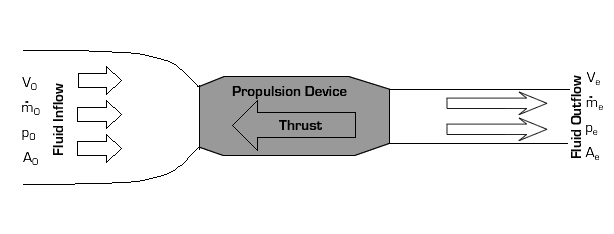
Mechanical Propulsion
In mechanical propulsion, fuel or some other stored energy is converted into mechanical energy by accelerating incoming fluid and thereby generating thrust in accordance with Newton’s Third Law. This is illustrated schematically below.

As discussed in the Principles section, the resulting thrust is given by

For propellers and subsonic jets operating at steady-state with (as is the usual case) fuel flow rates that are small compared to mass flow rate through the propulsion device, the thrust equation simplifies to

Thus, accelerating a larger amount of fluid (higher  ) to a higher velocity (larger Ve) generates more thrust. The amount of fuel required is in turn determined by the efficiency of the propulsion system. A more in-depth discussion of this can be found in the Principles section.
) to a higher velocity (larger Ve) generates more thrust. The amount of fuel required is in turn determined by the efficiency of the propulsion system. A more in-depth discussion of this can be found in the Principles section.
Specially designed equipment is required to convert the fuel energy into mechanical energy. Two common methods are propellers and jet engines. Although both systems aim to accelerate fluid in order to generate thrust, the methods used by each are different, resulting in different performance (thrust, efficiency, flight speed, etc.). The following pages will describe the basic operation of propeller-based propulsion systems, turbojets, and related systems.
 Qantas. Boeing 747-400. Photographed by Adrian Pingstone, March 2005. Click on the photo for the high resolution image. |
